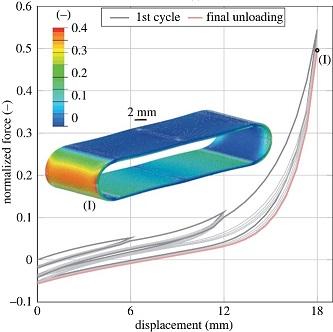Dissemination Results
The research group at TU-Graz has recently published two high-quality manuscripts as part of their work on modelling the anisotropic inelastic material behaviour of the electrospun polymers used in the fabrication of Xeltis’ tissue-engineered heart valves. In this setting, the biomechanical response of these polymers is both complex and challenging, not only mathematically but also from an in-silico point of view. It involves not only anisotropic material behaviour but also inelastic phenomena such as the Mullins effect, permanent set, and viscoelastic behaviour, which are clearly evident from the previous scaffold characterisation.
Initially, Wollner et al. successfully developed a material constitutive model capable of capturing the described nonlinear effects using a pseudo-elasticity approach. In this work, each of these effects is discussed separately in terms of its thermodynamics and mechanical interpretation.
In a subsequent study, Terzano et al. presented the numerical implementation of the anisotropic inelastic behaviour of the polymeric materials within a finite element framework, specifically in the user-defined subroutine of Abaqus. Moreover, they embedded their work within a thorough verification, validation, and uncertainty quantification plan, following ASME40 standards. These studies were published in “Journal of the Mechanics and Physics of Solids” (https://doi.org/10.1016/j.jmps.2023.105403) and “Journal of the Royal Society Interface” (https://doi.org/10.1098/rsif.2023.0318). For open-access, please se Wollner et al. (https://doi.org/10.1016/j.jmps.2023.105403) and Terzano et al. (https://doi.org/10.3217/jq38q-6tr65).

